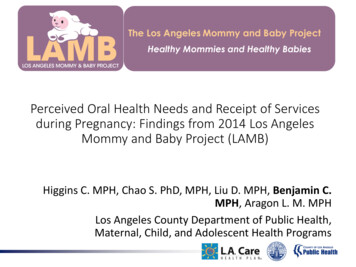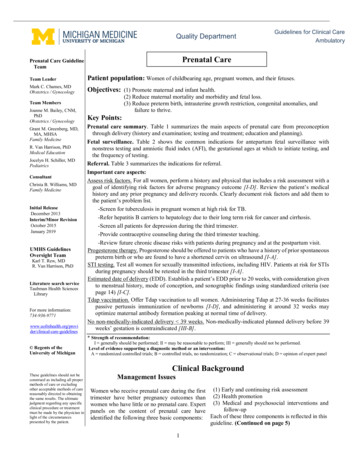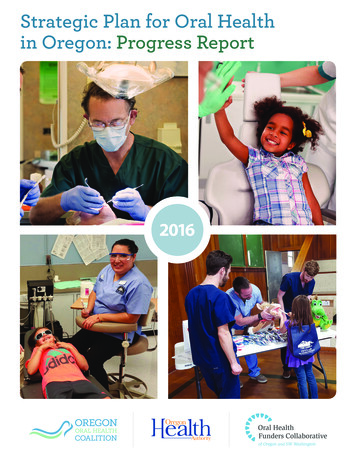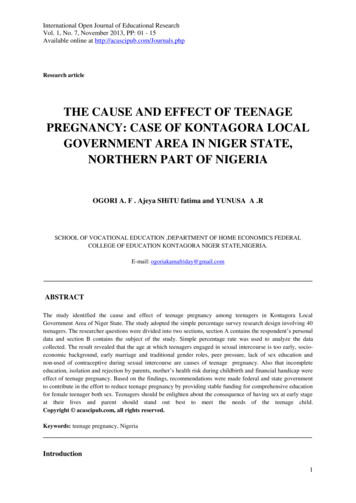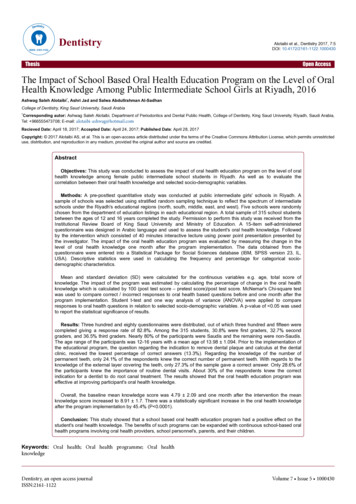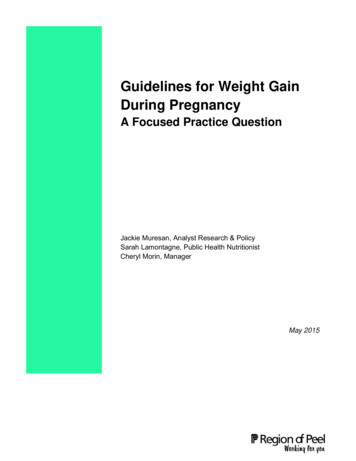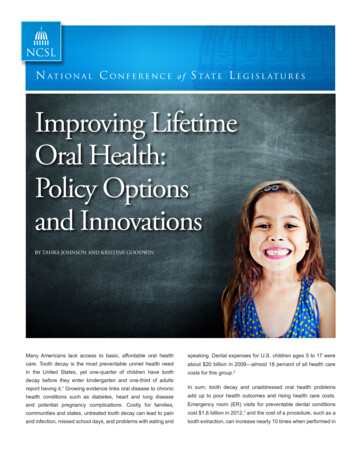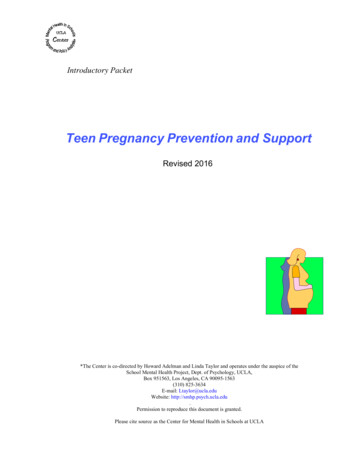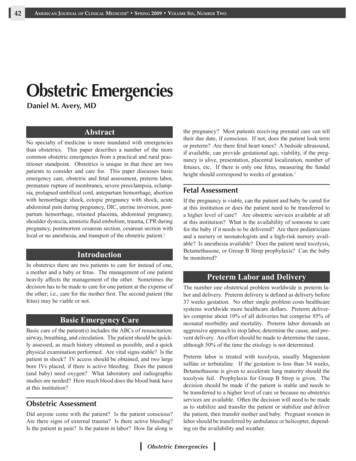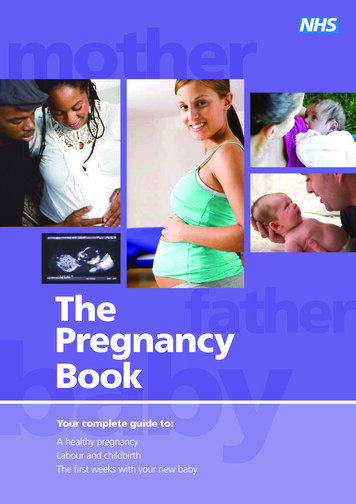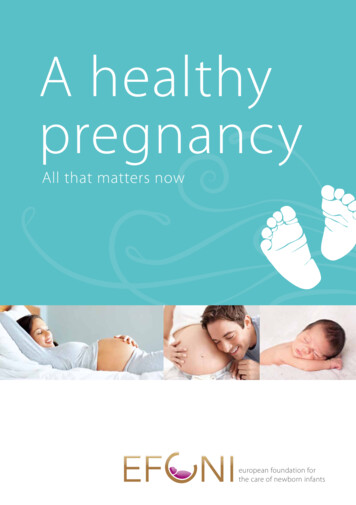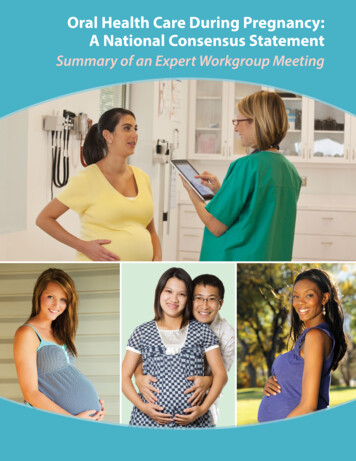
Transcription
Oral Health Care During Pregnancy:A National Consensus StatementSummary of an Expert Workgroup Meeting
Cite asOral Health Care During Pregnancy Expert Workgroup. 2012. Oral Health Care During Pregnancy: A NationalConsensus Statement—Summary of an Expert Workgroup Meeting. Washington, DC: National Maternal and ChildOral Health Resource Center.This publication was made possible by grant number H47MC00048 from the Maternal and Child Health Bureau(MCHB) (Title V, Social Security Act), Health Resources and Services Administration (HRSA), U.S. Department of Health and Human Services (DHHS). Its contents do not necessarily represent the official views ofMCHB, HRSA, or DHHS.Oral Health Care During Pregnancy: A National Consensus Statement—Summary of an Expert Workgroup Meeting 2012 by the National Maternal and Child Oral Health Resource Center, Georgetown UniversityPermission is given to photocopy this publication or to forward it, in its entirety, to others. Requests for permission to use all or part of the information contained in this publication in other ways should be sent to the addressbelow.National Maternal and Child Oral Health Resource CenterGeorgetown UniversityBox 571272Washington, DC 20057-1272Phone: (202) 784-9771Fax: (202) 784-9777E-mail: OHRCinfo@georgetown.eduWebsite: http://www.mchoralhealth.org
Oral Health CareDuring Pregnancy:A NationalConsensus StatementSummary of anExpert Workgroup MeetingOctober 18, 2011Georgetown University Hoteland Conference CenterWashington, DC 20007Sponsored byHealth Resources and Services AdministrationMaternal and Child Health BureauIn collaboration withAmerican College of Obstetricians and GynecologistsAmerican Dental Association
Table of ContentsIntroduction . . . . . . . . . . . . . . . . . . . . . . . . . . . . . . . . . . . . . . . . . . . . . . . . . . . . . . . . . . . . . . . . . . . . . . . . . . . . . . .1National Consensus Statement: Guidance forHealth Professionals . . . . . . . . . . . . . . . . . . . . . . . . . . . . . . . . . . . . . . . . . . . . . . . . . . . . . . . . . . . . . . . . .3Guidance for Prenatal Care Health Professionals . . . . . . . . . . . . . . . . . . . . . . . . . . . . . . . . . . . . . . . . . 3Assess Pregnant Women’s Oral Health Status . . . . . . . . . . . . . . . . . . . . . . . . . . . . . . . . . . . . . . . . . . . . . . . . . . . . . 3Advise Pregnant Women About Oral Health Care. . . . . . . . . . . . . . . . . . . . . . . . . . . . . . . . . . . . . . . . . . . . . . . . . . 3Work in Collaboration with Oral Health Professionals. . . . . . . . . . . . . . . . . . . . . . . . . . . . . . . . . . . . . . . . . . . . . . 4Provide Support Services (Case Management) to Pregnant Women . . . . . . . . . . . . . . . . . . . . . . . . . . . . . . . . . 4Improve Health Services in the Community . . . . . . . . . . . . . . . . . . . . . . . . . . . . . . . . . . . . . . . . . . . . . . . . . . . . . . . 4Guidance for Oral Health Professionals . . . . . . . . . . . . . . . . . . . . . . . . . . . . . . . . . . . . . . . . . . . . . . . . . . . . 5Assess Pregnant Women’s Oral Health Status . . . . . . . . . . . . . . . . . . . . . . . . . . . . . . . . . . . . . . . . . . . . . . . . . . . . . 5Advise Pregnant Women About Oral Health Care. . . . . . . . . . . . . . . . . . . . . . . . . . . . . . . . . . . . . . . . . . . . . . . . . . 5Work in Collaboration with Prenatal Care Health Professionals . . . . . . . . . . . . . . . . . . . . . . . . . . . . . . . . . . . . . 6Provide Pregnant Women with Oral Disease Treatment and Management . . . . . . . . . . . . . . . . . . . . . . . . . . 6Provide Support Services (Case Management) to Pregnant Women . . . . . . . . . . . . . . . . . . . . . . . . . . . . . . . . . 6Improve Health Services in the Community . . . . . . . . . . . . . . . . . . . . . . . . . . . . . . . . . . . . . . . . . . . . . . . . . . . . . . . 6Pharmacological Considerations for Pregnant Women . . . . . . . . . . . . . . . . . . . . . . . . . . . . . . . . . . 7Guidance for Health Professionals to Share with Pregnant Women . . . . . . . . . . . . . . . . . . . . 8Tips for Good Oral Health During Pregnancy . . . . . . . . . . . . . . . . . . . . . . . . . . . . . . . . . . . . . . . . . . . . . 9Get Oral Health Care . . . . . . . . . . . . . . . . . . . . . . . . . . . . . . . . . . . . . . . . . . . . . . . . . . . . . . . . . . . . . . . . . . . . . . . . . . . . 9Practice Good Oral Hygiene . . . . . . . . . . . . . . . . . . . . . . . . . . . . . . . . . . . . . . . . . . . . . . . . . . . . . . . . . . . . . . . . . . . . . 9Eat Healthy Foods . . . . . . . . . . . . . . . . . . . . . . . . . . . . . . . . . . . . . . . . . . . . . . . . . . . . . . . . . . . . . . . . . . . . . . . . . . . . . . 9Practice Other Healthy Behaviors . . . . . . . . . . . . . . . . . . . . . . . . . . . . . . . . . . . . . . . . . . . . . . . . . . . . . . . . . . . . . . . 10Resources . . . . . . . . . . . . . . . . . . . . . . . . . . . . . . . . . . . . . . . . . . . . . . . . . . . . . . . . . . . . . . . . . . . . . . . . . . . . . . . . . . . . . 10After Your Baby Is Born . . . . . . . . . . . . . . . . . . . . . . . . . . . . . . . . . . . . . . . . . . . . . . . . . . . . . . . . . . . . . . . . . . . . . . . . . 10Resources for Health Professionals. . . . . . . . . . . . . . . . . . . . . . . . . . . . . . . . . . . . . . . . . . . . . . . . .11Materials . . . . . . . . . . . . . . . . . . . . . . . . . . . . . . . . . . . . . . . . . . . . . . . . . . . . . . . . . . . . . . . . . . . . . . . . . . . . . . . . . . . . . . 11Organizations . . . . . . . . . . . . . . . . . . . . . . . . . . . . . . . . . . . . . . . . . . . . . . . . . . . . . . . . . . . . . . . . . . . . . . . . . . . . . . . . 12Appendix. . . . . . . . . . . . . . . . . . . . . . . . . . . . . . . . . . . . . . . . . . . . . . . . . . . . . . . . . . . . . . . . . . . . . . . . . . . . . . . . . . . .15Agenda . . . . . . . . . . . . . . . . . . . . . . . . . . . . . . . . . . . . . . . . . . . . . . . . . . . . . . . . . . . . . . . . . . . . . . . . . . . . . . . . . . . . . . . . 15Participant List . . . . . . . . . . . . . . . . . . . . . . . . . . . . . . . . . . . . . . . . . . . . . . . . . . . . . . . . . . . . . . . . . . . . . . . . . . . . . . . 16
IntroductionPregnancy is a unique period during a woman’slife and is characterized by complex physiological changes, which may adversely affectoral health. At the same time, oral health is key tooverall health and well-being. Preventive, diagnostic,and restorative dental treatment is safe throughoutpregnancy and is effective in improving and maintaining oral health.However, health professionals often do not provideoral health care to pregnant women. At the sametime, pregnant women, including some withobvious signs of oral disease, often do not seek orreceive care. In many cases, neither pregnant womennor health professionals understand that oralhealth care is an important component of a healthypregnancy.In addition to providing pregnant women with oralhealth care, educating them about preventing andtreating dental caries is critical, both for women’sown oral health and for the future oral health oftheir children. Evidence suggests that most infantsand young children acquire caries-causing bacteriafrom their mothers. Providing pregnant women withcounseling to promote healthy oral health behaviorsmay reduce the transmission of such bacteria frommothers to infants and young children, therebydelaying or preventing the onset of caries.For these reasons, it is essential for health professionals (e.g., dentists, dental hygienists, physicians, nurses,midwives, nurse practitioners, physician assistants)to provide pregnant women with appropriate andtimely oral health care, which includes oral healtheducation.Several national organizations have undertaken efforts to promote oral health for pregnant women. TheAmerican Academy of Pediatric Dentistry (AAPD),the American Academy of Pediatrics (AAP), theAmerican Academy of Periodontology, the American Academy of Physician Assistants, the AmericanCollege of Nurse-Midwives (ACNM), the AmericanCollege of Obstetricians and Gynecologists (ACOG),and the American Dental Association (ADA) haveissued statements and recommendations for improving oral health care during pregnancy.To reinforce these recommendations and to provide guidance to health professionals, the New YorkState Department of Health produced Oral HealthCare During Pregnancy and Early Childhood: PracticeGuidelines in 2006. Following publication of theseguidelines, AAPD, the California Dental Association Foundation, the South Carolina Department ofHealth and Environmental Control, and the University of Washington School of Dentistry also developed guidelines for perinatal oral health care.In 2008, an expert panel convened by the HealthResources and Services Administration’s (HRSA’s)Maternal and Child Health Bureau (MCHB) developed strategies for improving oral health care duringthe perinatal period, which were presented in Improving Perinatal Oral Health: Moving Forward. One ofthese strategies was to “promote the use of guidelinesaddressing oral health during the perinatal periodand disseminate the guidelines to maternal and childhealth professionals and oral health professionals.”This recommended strategy provided the charge forthe Oral Health Care During Pregnancy ConsensusDevelopment Expert Workgroup Meeting convenedby HRSA’s MCHB in collaboration with ACOG andADA and coordinated by the National Maternal andChild Oral Health Resource Center. The meeting was1
held on October 18, 2011, at Georgetown Universityin Washington, DC.The expert workgroup reviewed policies from federalagencies and national organizations, recent literature,and existing guidelines on oral health care duringpregnancy. (See Appendix: Agenda.) This workgroupidentified common ground to increase health professionals’ awareness of the importance and safety ofwomen’s oral health care during pregnancy throughthe promotion of evidence-based science. The nationalconsensus statement that resulted from the October2011 meeting comprises this document.This national consensus statement was developed tohelp health professionals, program administrators andstaff, policymakers, advocates, and other stakeholdersrespond to the need for improvements in the provision of oral health services to women during pregnancy. Ultimately, the implementation of the guidancewithin this consensus statement should bring aboutchanges in the health-care-delivery system and improve the overall standard of care.The expert workgroup consisted of individuals withexpertise in oral health and prenatal care with representation from national organizations includingAAP, AAPD, ACOG, ACNM, ADA, the AmericanDental Hygienists’ Association, the Association of2State and Territorial Dental Directors, the NationalMaternal and Child Oral Health Policy Center, andthe Medicaid-CHIP State Dental Association; federal agencies; as well as those involved in the development of existing perinatal oral health guidelines. (SeeAppendix: Participant List.)
National ConsensusStatement:Guidance for HealthProfessionalsGuidance for Prenatal CareHealth ProfessionalsPrenatal care health professionals may be the “firstline” in assessing pregnant women’s oral health andcan provide referrals to oral health professionals andreinforce preventive messages.Assess Pregnant Women’s Oral HealthStatusDuring the initial prenatal evaluation Take an oral health history. Following are examplesof questions that prenatal care health professionalsmay ask pregnant women. This information may begathered through a conversation or a questionnaire. Do you have swollen or bleeding gums, a tooth-ache (pain), problems eating or chewing food, orother problems in your mouth? Since becoming pregnant, have you been vomiting? If so, how often? Do you have any questions or concerns about getting oral health care while you are pregnant? When was your last dental visit? Do you needhelp finding a dentist? Check the mouth for problems such as swollen orbleeding gums, untreated dental decay (tooth witha cavity), mucosal lesions, signs of infection (e.g., adraining fistula), or trauma.Document your findings in the woman’s medicalrecord. Advise Pregnant Women About OralHealth Care Reassure women that oral health care, including useof radiographs, pain medication, and local anesthesia,is safe throughout pregnancy. If the last dental visit took place more than 6months ago or if any oral health problems wereidentified during the assessment, advise women toschedule an appointment with a dentist as soon aspossible. If urgent care is needed, write and facilitate a formal referral to a dentist who maintainsa collaborative relationship with the prenatal carehealth professional.Encourage women to seek oral health care, practice good oral hygiene, eat healthy foods, andattend prenatal classes during pregnancy. (SeeGuidance for Health Professionals to Share withPregnant Women.)Counsel women to follow oral health professionals’recommendations for achieving and maintainingoptimal oral health.3
Improve Health Services in theCommunity Work in Collaboration with OralHealth Professionals Establish relationships with oral health professionals in the community. Develop a formal referralprocess whereby the oral health professional agreesto see the referred individual in a timely manner(e.g., that day, the following day) and to providesubsequent care.Share pertinent information about pregnant womenwith oral health professionals, and coordinate carewith oral health professionals as appropriate.Provide Support Services (CaseManagement) to Pregnant Women 4Help pregnant women complete applicationsfor insurance or other sources of coverage, socialservices (e.g., domestic violence services), or otherneeds (e.g., transportation, translation).If the woman does not have a dental home,explain the importance of optimal oral health during pregnancy. Help her obtain care by facilitatingreferrals to oral health professionals in the community, including those who serve pregnant womenenrolled in Medicaid and other public insuranceprograms, or by contacting a dental office toschedule care.On the patient-intake form, include questionsabout oral health (e.g., name and contact information of oral health professional, reason for and dateof last dental visit, previous dental procedures).Establish partnerships with community-basedprograms (e.g., Special Supplemental NutritionProgram for Women, Infants and Children [WIC],Early Head Start) that serve pregnant women withlow incomes.Provide a referral to a nutrition professional ifcounseling (e.g., guidance on food choices or nutrition-related health problems) would be beneficial.Integrate oral health topics into prenatal classes.Provide culturally and linguistically appropriatecare. Take the time to ensure that women understand the information shared with them.
Guidance for Oral HealthProfessionalsActivities described below are performed by oral healthprofessionals as allowed by state practice acts.Assess Pregnant Women’s Oral HealthStatus Take an oral health history. Following are examplesof questions that oral health professionals may askpregnant women. This information may be gatheredthrough a conversation or a questionnaire. When and where was your last dental visit? Do you have swollen or bleeding gums, a tooth-ache (pain), problems eating or chewing food, orother problems in your mouth? How many weeks pregnant are you? (When is your due date?) Since becoming pregnant, have you been vomit-Do you have any questions or concerns about getting oral health care while you are pregnant?ing? If so, how often? Have you received prenatal care? If not, do youneed help making an appointment for prenatalcare? In addition to reviewing the dental history, reviewmedical and dietary histories, including use oftobacco, alcohol, and recreational drugs.Perform a comprehensive oral examination, whichincludes a risk assessment for dental caries andperiodontal disease.Take radiographs to evaluate and definitively diagnose oral diseases and conditions when clinicallyindicated.Advise Pregnant Women About OralHealth Care Reassure women that oral health care, includinguse of radiographs, pain medication, and localanesthesia, is safe throughout pregnancy.Encourage women to continue to seek oral healthcare, practice good oral hygiene, eat healthy foods,and attend prenatal classes during pregnancy. (SeeGuidance for Health Professionals to Share with Pregnant Women.)5
Use standard practice when placing restorativematerials such as amalgam and composite.Use a rubber dam during endodontic proceduresand restorative procedures.Position pregnant women appropriately during care: Keep the woman’s head at a higher level than herfeet. Place woman in a semi-reclining position, astolerated, and allow frequent position changes. Place a small pillow under the right hip, or have theWork in Collaboration with PrenatalCare Health Professionals Establish relationships with prenatal care healthprofessionals in the community. Develop a formalreferral process whereby the prenatal care healthprofessional agrees to see the referred individual ina timely manner (e.g., that day, the following day)and to provide subsequent care.Share pertinent information about pregnant womenwith prenatal care health professionals, and coordinate care with prenatal care health professionals asappropriate.woman turn slightly to the left as needed to avoiddizziness or nausea resulting from hypotension. Provide Support Services (CaseManagement) to Pregnant Women Consult with prenatal care health professionals,as necessary—for example, when considering thefollowing: Co-morbid conditions that may affect manage-ment of oral problems (e.g., diabetes, hypertension,pulmonary or cardiac disease, bleeding disorders). The use of intravenous sedation or generalto local anesthetics.Provide Oral Disease Managementand Treatment to Pregnant Women 6Provide emergency or acute care at any time duringthe pregnancy, as indicated by the oral condition.Develop, discuss with women, and provide acomprehensive care plan that includes prevention,treatment, and maintenance throughout pregnancy.Discuss benefits and risks of treatment and alternatives to treatments.Help pregnant women complete applications for insurance or other sources of coverage, social services(e.g., domestic violence services), or other needs(e.g., transportation, translation).If the woman does not have a prenatal care healthprofessional, explain the importance of care. Facilitate referrals to prenatal care health professionals inthe community, especially those who accept Medicaid and other public insurance programs.Improve Health Services in theCommunity anesthesia. The use of nitrous oxide as an adjunctive analgesicFollow up with pregnant women to determinewhether preventive and restorative treatment hasbeen effective. On the patient-intake form, record the name andcontact information of the prenatal care healthprofessional.Accept women enrolled in Medicaid and otherpublic insurance programs.Establish partnerships with community-basedprograms (e.g., WIC, Early Head Start) that servepregnant women with low incomes.Provide a referral to a nutrition professional ifcounseling (e.g., guidance on food choices or nutrition-related health problems) would be beneficial.Provide culturally and linguistically appropriatecare. Take the time to ensure that women understand information shared with them.
Pharmacological Considerations for Pregnant WomenThe pharmacological agents listed below are to be used only for indicated medical conditions and with appropriatesupervision.Pharmaceutical AgentIndications, Contraindications, and Special ConsiderationsAnalgesicsAcetaminophenAcetaminophen with Codeine,Hydrocodone, or OxycodoneCodeineMay be used during pregnancy. Oral pain can often be managed with nonopioid medication. If opioids are used, prescribe the lowest dose for theshortest duration (usually less than 3 days), and avoid issuing refills to reducerisk for dependency.MeperidineMorphineAspirinIbuprofenMay be used in short duration during pregnancy; 48 to 72 hours. Avoid in1st and 3rd trimesters.NaproxenAntibioticsAmoxicillinMay be used during nicillinCiprofloxacinAvoid during tracyclineNever use during pregnancy.AnestheticsConsult with a prenatal care health professional before using intravenoussedation or general anesthesia. Limit duration of exposure to less than 3 hoursin pregnant women in the third trimester.Local anesthetics with epinephrine(e.g., Bupivacaine, Lidocaine, Mepivacaine)May be used during pregnancy.Nitrous oxide (30%)May be used during pregnancy when topical or local anesthetics areinadequate. Pregnant women require lower levels of nitrous oxide to achievesedation; consult with prenatal care health professional.AntimicrobialsUse alcohol-free products during pregnancy.Cetylpyridinium chloride mouth rinseMay be used during pregnancy.Chlorhexidine mouth rinseXylitolTable updated 2017.
Guidance for HealthProfessionals to Share withPregnant WomenGuidance provided to pregnant women should bemodified based on risk assessment. Creating opportunities for thoughtful dialogue between pregnantwomen and health professionals is one of the mosteffective ways to establish trust and build a partnership that promotes health and prevents disease.Share the information on the following two pageswith pregnant women. In addition to discussing theinformation with pregnant women, health professionals may photocopy the pages, or download and printthem, to serve as a handout.SourcesAmerican Academy of Pediatric Dentistry. 2011. Guideline onperinatal oral health care. Reference Manual 33(6):118–123.http://www.aapd.org/media/Policies Guidelines/G PerinatalOralHealthCare.pdf.CDA Foundation. 2010. Oral Health During Pregnancy & EarlyChildhood: Evidence-Based Guidelines for Health Professionals.Sacramento, CA: CDA Foundation. http://www.cdafoundation.org/Portals/0/pdfs/poh guidelines.pdf.Kumar J, Iida H. 2008. Oral Health Care During Pregnancy:A Summary of Practice Guidelines. Washington, DC: NationalMaternal and Child Oral Health Resource Center. http://www.mchoralhealth.org/PDFs/Summary PracticeGuidelines.pdf.Kumar J, Samelson R, eds. 2006. Oral Health Care During Pregnancy and Early Childhood: Practice Guidelines. Albany, NY:New York State Department of Health. f.Northwest Center to Reduce Oral Health Disparities. 2009.Guidelines for Oral Health Care in Pregnancy. Seattle, WA:University of Washington School of Dentistry. files/oral healthpregnancy 0.pdf.8
Tips for Good Oral Health During PregnancyBelow are tips for taking care of your oral healthwhile you are pregnant. Getting oral health care,practicing good oral hygiene, eating healthy foods,and practicing other healthy behaviors will helpkeep you and your baby healthy. Delaying necessary treatment for dental problems could result insignificant risk to you and your baby (for example,a bad tooth infection in your mouth could spreadthroughout your body). Practice Good Oral Hygiene Get Oral Health Care Taking care of your mouth while you arepregnant is important for you and your baby.Changes to your body when you are pregnantcan make your gums sore or puffy and can makethem bleed. This problem is called gingivitis(inflammation of the gums). If gingivitis is nottreated, it may lead to more serious periodontal(gum) disease. This disease can lead to toothloss.Oral health care, including use of X-rays,pain medication, and local anesthesia, is safethroughout pregnancy.Get oral health treatment, as recommended byan oral health professional, before delivery.If your last dental visit took place more than6 months ago or if you have any oral healthproblems or concerns, schedule a dentalappointment as soon as possible.Tell the dental office that you are pregnant andyour due date. This information will help thedental team provide the best care for you. Brush your teeth with fluoridated toothpastetwice a day. Replace your toothbrush every 3or 4 months, or more often if the bristles arefrayed. Do not share your toothbrush. Cleanbetween teeth daily with floss or an inter dentalcleaner.Rinse every night with an over-the-counterfluoridated, alcohol-free mouthrinse.After eating, chew xylitol-containing gum or useother xylitol-containing products, such as mints,which can help reduce bacteria that can causetooth decay.If you vomit, rinse your mouth with a teaspoonof baking soda in a cup of water to stop acidfrom attacking your teeth.Eat Healthy Foods Eat a variety of healthy foods, such as fruits;vegetables; whole-grain products like cereals,bread, or crackers; and dairy products likemilk, cheese, cottage cheese, or unsweetenedyogurt. Meats, fish, chicken, eggs, beans, andnuts are also good choices.Eat fewer foods high in sugar like candy,cookies, cake, and dried fruit, and drink fewerbeverages high in sugar like juice, fruit-flavoreddrinks, or pop (soda).For snacks, choose foods low in sugar, such asfruits, vegetables, cheese, and unsweetened yogurt.To help choose foods low in sugar, read foodlabels.If you have problems with nausea, try eatingsmall amounts of healthy foods throughout theday.Drink water or milk instead of juice, fruitflavored drinks, or pop (soda).
Drink water throughout the day, especiallybetween meals and snacks. Drink fluoridatedwater (via a community fluoridated watersource) or, if you prefer bottled water, drinkwater that contains fluoride.To reduce the risk of birth defects, get 600micrograms of folic acid each day throughoutyour pregnancy. Take a dietary supplement offolic acid and eat foods high in folate and foodsfortified with folic acid. Examples of thesefoods include Asparagus, broccoli, and green leafy vegetables, such as lettuce and spinach Legumes (beans, peas, lentils) Papaya, oranges, strawberries, cantaloupe, andbananas Grain products fortified with folic acid (breads,cereals, cornmeal, flour, pasta, white rice)Practice Other Healthy Behaviors Attend prenatal classes.Stop any use of tobacco products and recreational drugs. Avoid secondhand smoke.Stop any consumption of alcoholic beverages.ResourcesCavity Keep Away (brochure and poster in English andSpanish) produced by the California Dental AssociationFoundation. terial.aspx.and Texas Oral Health Coalition. http://www.youtube.com/watch?v 4m41tR3s9sE (English), http://www.youtube.com/watch?v vuYTLjXG-do (Spanish).Patient Education Tools (articles in Chinese, English, Hmong,Russian, Spanish, and Vietnamese) produced by theCalifornia Dental Association. http://www.cda.org/page/patient education tools.Pregnancy and Dental Care (poster and wallet card) producedby the New York State Department of Health. blications.htm.text4baby (mobile information service) produced by theNational Heal thy Mothers, Healthy Babies Coalition.http://www.text4baby.org.Two Healthy Smiles: Tips to Keep You and Your Baby Healthy(brochures) produced by the National Maternal and ChildOral Health Resource Center. e.pdf (English) and e sp.pdf (Spanish).Finding a Dentist .aspx http://www.knowyourteeth.com/findadentistFinding Low-Cost Dental Care Cost/FLCDC.htmFinding Dental Insurance Coverage https://www.healthcare.govAfter Your Baby Is Born Dental Care Before, During, and After Pregnancy (handout)produced by the South Carolina Department of Health andEnvironmental Control, Division of Oral Health. 9602.pdf.For the Dental Patient: Oral Health During
about oral health (e.g., name and contact informa-tion of oral health professional, reason for and date of last dental visit, previous dental procedures). Establish partnerships with community-based programs (e.g., Special Supplemental Nutrition Program for Women, Infants and Children [WIC], Early Head Start) that serve pregnant women with
